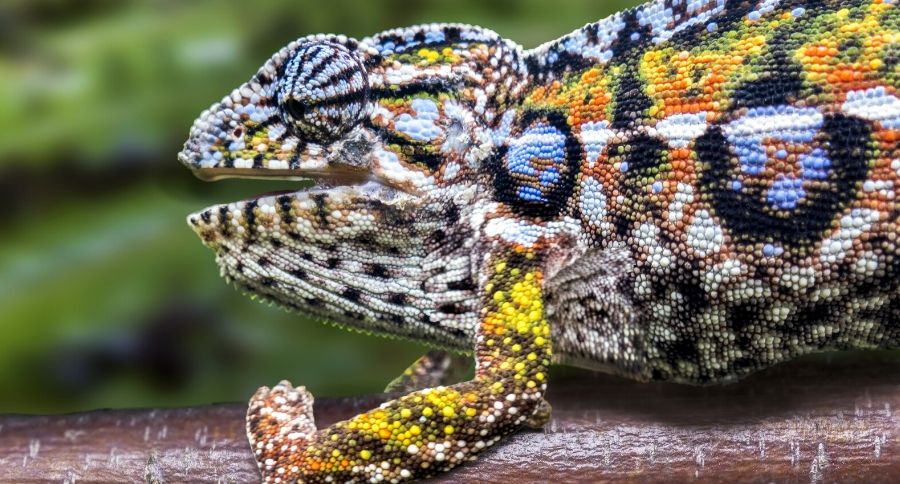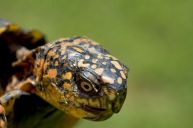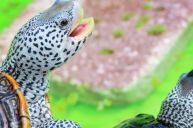Panther chameleons are not exactly what you think.
Folks reading about chameleons typically think they change colors to reflect whatever environment they're in. Some will be surprised to learn that the panther chameleon does not change color to instantly match any background it is placed against. Reptiles Magazine explains that this happens for a lot of reasons.
"Panthers do exhibit color change, though, for a variety of reasons, including a method of communication, to better absorb or reflect radiant heat, and to blend in with natural habitat."
Another interesting fact? These sweet little reptiles were imported from Madagascar in the 1980s. They live 3 to 7-years-old.
Here's a care guide about the Panther chameleons so you have some details before you bring home a captive-bred individual.
Behavior and temperament
This is not a pet that should be handled. They get stressed really easily! It's better to observe these pets than pick them up a lot.
Panther chameleons are territorial and should be housed individually.
The Exotic Pet Vet says you should approach with deliberate slow movements.
"Position one hand under the front half of the body and carefully unwind the tail with the other hand. Chameleons do not have the autonomy ability (ability to self amputate the tail) and if the tail is injured or broken it will not regenerate."
Habitat and enclosures
No glass terrariums!
Here's what we learned about housing from The Spruce Pets.
- The need a vertical environment like the picture here and ventilation provided by a mesh enclosure. Fine metal or fiberglass mesh is not recommended for chameleon enclosures; PVC coated hardware cloth is good.
- A cage size of 36 inches by 24 inches by 36 to 48 inches tall is recommended.
- They need a warm basking area of 90of during the day. Provide this heat over 1/3 of the enclosure while letting the rest of the enclosure cool to 70of on the opposite side.
"To achieve this we attach a strong basking lamp to the ceiling of the enclosure on one side. This is surrounded by a guard and controlled by a high-temperature dimming thermostat to make sure that the temperature is kept correct throughout the day. The basking lamp is left on for 10-12 hours per day."
- Panther chameleons need a high humidity level; it's best to aim for between 60 and 85 percent.
- Cleanliness in the cage is vital to prevent bacterial or mold growth. Using paper towels or newspaper to line the cage makes cleaning easiest.
- Provide lots of sturdy non-toxic plants and branches. Ficus trees have often been used in chameleon housing, but require some caution as the sap can be irritating. Other plants you could try include pothos, hibiscus, and dracaena.
Feeding and water
You must offer high-quality crickets, earthworms, mealworms, and even cockroaches. All insects, except earthworms, must be 'gut-loaded' and fed a high calcium diet.
You should read this article on Reptiles Magazine site as water for your Panther is complicated and nuanced.
"Water provides panther chameleons with three critical benefits: hydration, adequate relative humidity, and a way for them to keep their eyes clean. Providing them with water requires a different approach than with most terrestrial lizards. With very rare exceptions, panthers will not reliably drink from water dishes. Instead, they are attracted to water that moves and/or glistens. We provide this by misting and dripping the enclosure foliage, either manually or automatically."
How to choose the best Panther chameleon
You really need to go to a reputable breeder. In this case, a captive-bred Panther is the direction experts recommend.
We recommend this with all reptiles.
If you're worried about common health problems you need to worry about calcium and vitamin A deficiencies. This condition is usually the result of a poor diet.
You should refer to the experts and articles we mention in this story about this chameleon species! This care sheet is simply a summary of the type of chameleon cage, misting system, basking spot, live plants, screen cages, ceramic heat emitters, UVB lights, and food like waxworms, silkworms and super worms they need! Panther chameleon care is complicated! Don't put two adult males together.
There is a lot of research on captive-bred vs. wild-caught Panthers. The coloration of the captive-bred Panthers is beautiful. We bet baby Panther chameleons are adorable!
Do you live with a chameleon? What essentials did we miss? Please leave us a comment below!
WATCH NOW: Bearded Dragons Are Awesome Reptiles!




